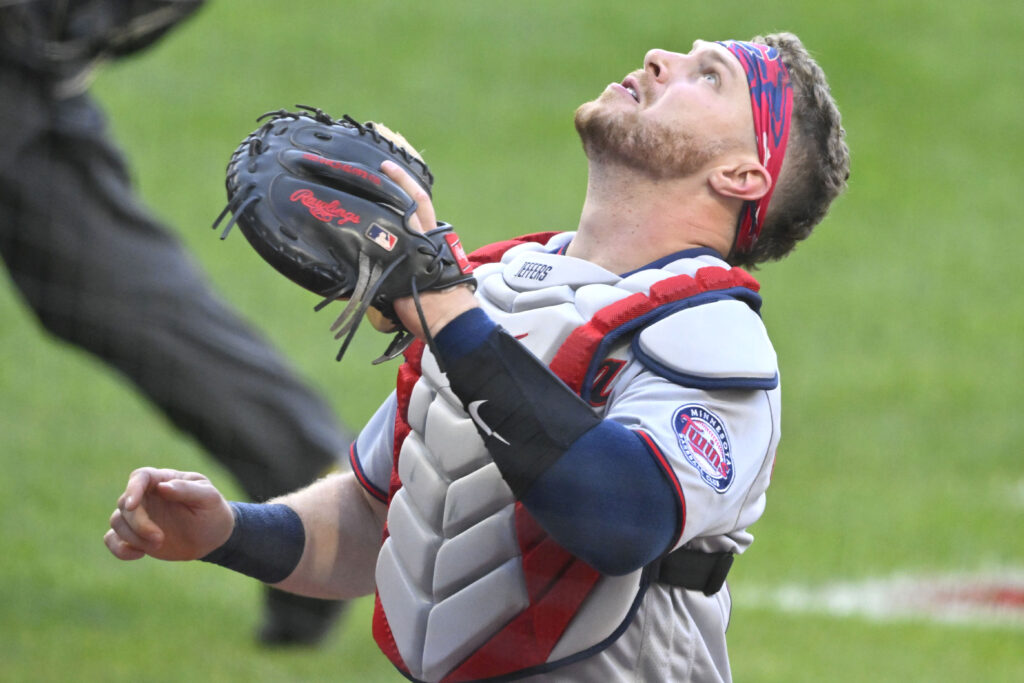
Though the Twins’ top priority at the moment is likely ascertaining whether they have a real chance to extend Carlos Correa before he formally triggers his opt-out clause, they’ll head into the winter with a lengthy list of needs. Among the priorities will be looking for some help behind the plate. President of baseball ops Derek Falvey recently spoke of the “co-catcher” model — that is, two catchers splitting time more evenly rather than a conventional starter/backup committee (link via Aaron Gleeman of The Athletic). He implied that there’s “an opportunity to match up” right-handed-hitting Ryan Jeffers with a partner who can provide some more offense against right-handed pitching.
Falvey notably emphasized that Jeffers isn’t viewed as a strict platoon candidate, but there’s little denying that the 25-year-old has been vastly more productive in platoon matchups to this point in his career. Jeffers hit .306/.377/.532 in a small sample of 70 plate appearances against southpaws this season and carries a career .263/.344/.450 output against left-handers. Comparatively, he’s batted just .185/.256/.361 against right-handers. From a pure power standpoint, Jeffers’ .187 ISO against lefties and .176 mark versus righties are comparable, but Jeffers strikes out more often and walks less against same-handed opponents. He also makes far less hard contact against righties and pops up nearly four times as often in those matchups as he does against lefties.
While the pure offensive splits do speak to a potential platoon scenario being advantageous, it’s also worth pointing out that Jeffers is still young and any such numbers are coming in a small sample. Though he’s been a prominent factor in the Twins’ catching mix since late in the 2020 season, injuries have limited his availability. Most recently, spent more than two months on the injured list this season due to a fractured thumb. Considering that Jeffers hit .276/.362/.427 against righties in his final full minor league season (2019), the Twins may not want to completely cut off his avenue to at-bats against right-handed pitching; there’s still time for him to improve in that regard.
Beyond that, limiting Jeffers to a platoon setup inherently subtracts as quality defensive player from the lineup. True, Jeffers’ 19% caught-stealing rate is five percentage points below the league average during his three years in the Majors, but he regularly grades out as a strong framer and has long drawn praise for his receiving skills on the whole. In about a season’s worth of innings over the past two years, he’s been credited for eight Defensive Runs Saved.
Still, there’s some obvious cause to add not just catching option who can provide some clout against right-handed opponents, but one who can shoulder the workload in the event of any additional absences from Jeffers. This year’s injury was fluky in nature, but the Twins’ system is generally thin on catching prospects at the moment, so adding a veteran who can step up and take a bigger role, if needed, makes good sense.
Unfortunately, among this year’s group of free-agent catchers, the options in that regard are fairly limited. Certainly, the market’s top catcher, Willson Contreras, would provide some extra thump against right- and left-handed pitching alike (and bring more than enough bat to occasionally mix in at DH), but the competition for him figures to be strong. Some lefty-swinging backstops are available in the form of Omar Narvaez and switch-hitting Tucker Barnhart, but neither did much against righties or lefties in 2022. Both are coming off down seasons, though Narvaez in particular does carry a career .268/.345/.406 line against right-handers. The trade market will present everything from top-tier regularsi (Oakland’s Sean Murphy) to out-of-options rolls of the dice (the Angels’ Matt Thaiss).
The quintet of Jeffers, Gary Sanchez, Sandy Leon, Caleb Hamilton and Jose Godoy combined for a .197/.275/.355 batting line while catching in 2022, equating to an 81 wRC+ that ranked 17th in the Majors. Twins catchers were far from the sport’s least-productive unit, but that’s as much an indictment on the current production (or lack thereof) from catchers throughout the league as a testament to the Twins’ catching corps. Whichever route Falvey and his staff take, some form of complement to Jeffers feels inevitable. And, with only about $52.5MM on next year’s payroll (when factoring in Correa’s opt-out and the likely exercising of Sonny Gray’s club option), there’s plenty of room for upgrades up and down the roster.
Credit : Source link






